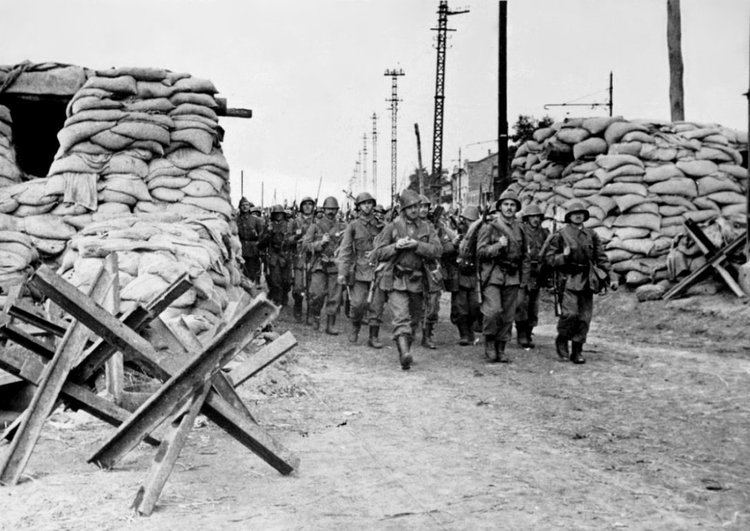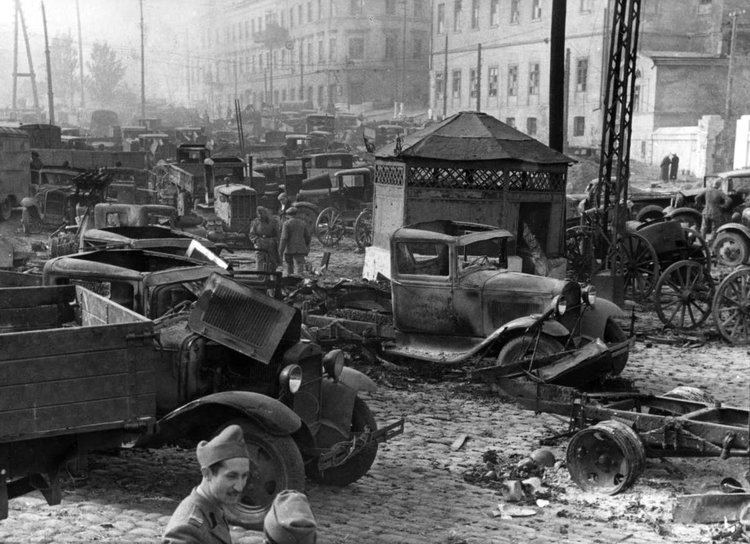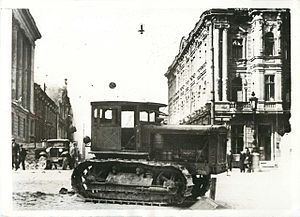Dates 8 Aug 1941 – 16 Oct 1941 | ||
 | ||
160,000 men (initially)
340,223 men (total) 34,500 men (initial)
240 artillery pieces
120,000+ men (total) 92,545 overall
17,729 dead
63,345 wounded
11,471 missing
19 tanks
90 artillery pieces
20 aircraft Low estimate 41,268 overall
16,578 dead/missing
24,690 wounded
1 armored train
151 aircraft
1 destroyer damaged
1 auxiliary minesweeper sunk
High estimate 60,000 overall Result Axis victory, subsequent 1941 Odessa massacre Combatants Soviet Union, Germany, Nazi Germany, Romania, Kingdom of Romania Similar Eastern Front, World War II, Siege of Sevastopol, Battle of Kiev, Battle of Smolensk | ||
The Siege of Odessa, known to the Soviets as the Defence of Odessa, lasted from 8 August until 16 October 1941, during the early phase of Operation Barbarossa, the Axis invasion of the Soviet Union during World War II.
Contents

Odessa was a port on the Black Sea in the Ukrainian SSR. On 22 June 1941, the Axis powers invaded the Soviet Union. In August, Odessa became a target of the Romanian 4th Army and elements of the German 11th Army. Due to the heavy resistance of the Soviet 9th Independent Army and the rapidly formed Separate Coastal Army, supported by the Black Sea Fleet, it took the Axis forces 73 days of siege and four assaults to take the city. Romanian forces suffered 93,000 casualties, against Red Army casualties estimated to be between 41,000 and 60,000.

Prelude
On 27 July 1941, Hitler sent a letter to General Ion Antonescu in which he recognised the Romanian administration of the territory between the Dniester and the Bug rivers. The Romanian Third Army had already crossed the Dniester on 17 July. Lieutenant-general Nicolae Ciupercă's Fourth Army advanced over the river on 3 August, with the 5th Corps, comprising the 15th Infantry Division and 1st Cavalry Brigade, joined by the 1st Armored Division. On 8 August, the Romanian General Staff issued the Operative Directive No. 31 instructing the 4th Army to occupy Odessa off the march. It was thought that the city garrison, which was heavily outnumbered, would surrender quickly.
Odessa was heavily fortified by three defensive lines and, thanks to the presence of the Soviet Black Sea Fleet, could not be completely surrounded. The first line was 80 km long and situated 25–30 km from the city. The second and main line of defense was situated 6–8 km from the city and was about 30 km long. The third and last line of defense was organized inside the city itself. The forces that initially manned the fortifications were made up of the 25th and 95th Rifle Divisions, the 2nd Cavalry Division, the 421st Rifle Division, the 54th Rifle Regiment and an NKVD Regiment. The Red Army had 34,500 men and 240 artillery pieces in the area. Air support was provided by the 69 IAP, two seaplane squadrons and one bomber squadron. Later, other fighters joined the defenders, as did an Il-2 squadron.
Battle
The defense of Odessa lasted 73 days from 5 August to 16 October 1941. On 10 August, in the sector of the 3rd Corps, the bulk of the 7th Infantry Division reached Elssas, while the 1st Guard Division arrived on the alignment Strassburg – Petra Evdokievka. In the sector of the 5th Corps, the 1st Armored Division broke through Odessa's first line of defense. That evening, the Romanian division reached the second line of defense. The 1st Cavalry Brigade took Severinovka and joined the 1st Armored Division. At the same time, the 10th Dorobanţi Regiment overran the Soviet forces at Lozovaya. The 4th Army gradually closed the circle around Odessa, but the offensive was temporarily stopped by Antonescu on 13 August to strengthen the line west of the Hadjibey bank.
The offensive resumed on 16 August, as Romanian troops attacked along the entire line, capturing Odessa's water reservoirs on 17 August. The Soviet forces put up a stubborn resistance, launching repeated counter-attacks, inflicting and taking heavy casualties. The Royal Romanian Air Force actively supported the ground troops, disrupting Soviet naval traffic to and from Odessa, and also destroying an armored train on 20 August.
In support of the land offensive, the Romanian Navy dispatched motor torpedo boats to the recently occupied port of Ochakiv (Oceacov in Romanian). During the night of 18 August, the motor torpedo boats NMS Viscolul and NMS Vijelia attacked a Soviet supply convoy (light cruiser Komintern, two destroyers, four gunboats, forty motor torpedo boats and seven auxiliary minesweepers) South of Odessa, damaging one destroyer. It was one of the few actions the Romanian Navy undertook to support the siege, generally limiting itself to patrols of the submarine Delfinul. On 20 August, while returning to Constanța from a week-long patrol, Delfinul was attacked by the Soviet M-class submarine M-33 with a torpedo, which missed. In order to counter the Romanian MTBs operating in the area, on 15 September, the Soviet Leninets-class submarine L-5 laid mines off Ochakiv. However, these mines had a negative effect, sinking the Soviet auxiliary minesweeper Groza on 17 September.
By 24 August, despite constant attacks, the Romanians were bogged down in front of the Soviets' main line of defense. The 4th Army had already suffered 27,307 casualties, including 5,329 killed in action. Nevertheless, the Soviets were also weakened, and thanks to the capture of Kubanka, Romanian heavy artillery now threatened the port of Odessa. Over the next three days, there was a lull in the fighting.
On 28 August, the Romanians resumed their offensive, reinforced by a German assault battalion and ten heavy artillery battalions. The 4th, 11th and 1st Army Corps advanced towards Gnileakovo and Vakarzhany, only to be pushed back in some areas by a strong Soviet counterattack the following day. On 30 August the Romanians retook the initiative, but gained very little ground. Hitler and the German High Command noted that 'Antonescu [was] using at Odessa the tactics of the First World War,' crudely depending upon infantry to make unsupported frontal attacks against Soviet trench line defenses. The Soviets temporarily retook Kubanka but were driven back by nightfall. Soviet troops in Vakarzhany were encircled and continued to fight until 3 September, when combined German and Romanian infantry successfully stormed the village.
On 3 September, General Ciupercă submitted a memoir to by-now Marshal Antonescu, highlighting the poor condition of the front-line divisions, which were exhausted after nearly a month of continuous fighting. He proposed a reorganization of six divisions (the 3rd, 6th, 7th, 14th, 21st Infantry and Guard Divisions), which would be split into 2 corps and supported by 8 heavy artillery battalions. These units would then attack in a single area to break through the Soviet line. The memoir however, was rejected by both Antonescu and Brigadier-General Alexandru Ioaniţiu, chief of the Romanian General Staff, who argued that an attack in a single direction would leave the rest of the Romanian line too exposed. Marshal Antonescu subsequently issued a new directive calling for attacks between Tatarka and Dalnik, and Gniliavko and Dalnik, to be made by the 11th and 3rd Corps, respectively. Ioaniţiu forwarded a note to Major-General Arthur Hauffe, chief of the German military mission to Romania, informing him of the situation at Odessa and requesting assistance in the form of aircraft and several pioneer battalions. Although the Royal Romanian Air Force enjoyed some success against the Soviets ground and air forces, it was ill-equipped for anti-shipping raids, and the Soviets were being steadily reinforced and resupplied via the Navy.
Meanwhile, the Romanian offensive was halted to wait for reinforcements. A German detachment led by Lieutenant-General René von Courbier and comprising one infantry regiment, one assault pioneer regiment and two artillery regiments arrived. Concurrently, the Soviets also received 15,000 men and ammunition. On 9 September, Ciupercă was replaced by Lieutenant-General Iosif Iacobici, who was expressly ordered to follow the General Staff's directives without question. The offensive resumed on 12 September, but was again stopped temporarily on September 14 as Romanian and German artillery units were running low on ammunition. Two Vânători battalions were encircled by Red Army troops near the Hadjibey bank, but were eventually relieved despite Soviet efforts to annihilate them.
On the night of 15 September, Soviet troops broke contact with the Romanian 1st Corps and retreated toward the southeast. On 16 September, the 1st Corps took the heights northwest of Gross-Liebenthal. Romanian troops also occupied the area south of the Sukhoy bank. Over 3,000 Soviet soldiers were captured, but these losses were replaced by the 157th Rifle Division, with a strength of 12,600 troops. Also, 18 Soviet companies were brought in from Novorossiysk. Partisan fighting continued, however, in the city's catacombs.
With the advance of Axis forces into the Soviet Union, STAVKA decided to evacuate the defenders of Odessa. On the night of 14–15 October 1941, the Black Sea Fleet evacuated the garrison to Sevastopol where most of the units were later destroyed in the bitter fighting that took place there during the Defence of Sevastopol. The Black Sea Fleet also managed to evacuate 350,000 soldiers and civilians.
Lyudmila Pavlichenko, the world's best female sniper, took part in the battle. Her first 2 kills were made near Belyayevka using a Mosin–Nagant bolt-action rifle with a P.E. 4-power scope. She recorded 187 confirmed kills during defense of Odessa. Pavlichenko’s total confirmed kills during World War II was 309 (including 36 snipers).
Aftermath
The operations at Odessa highlighted significant weaknesses in the Romanian Army, leading both military and political leaders in the country to call for a discontinuation of military operations against the Soviet Union. Antonescu ignored such objections, regarding continued participation and eventual victory on the Eastern Front as necessary for the restoration of Romania's territorial integrity.
Casualties suffered during the Siege of Odessa were:
The recapture of Bessarabia and Northern Bukovina in Operation München and the subsequent victory at Odessa led to a partial demobilization of the Romanian army, which was reduced in size from nearly 900,000 personnel on 1 October to 465,000 on 1 January 1942. Politically, the presence of Romanian troops in Odessa and the establishment of the Transnistria Governorate led to a deterioration of Romania's international situation, with the British declaring war on Romania on 6 December, and on 12 December Romania declared war on the United States in solidarity with Germany and Japan.
Commemoration
The Soviet Union established the Medal "For the Defence of Odessa" on 22 December 1942. Approximately 38,000 people were the recipients, including military (Army and Navy) personnel and civilian defenders. Odessa was one of the first four Soviet cities to be awarded the title of "Hero City" in 1945, the others being Leningrad, Stalingrad, and Sevastopol.
Museum of the Heroic Defense of Odessa (411th Coastal Battery Memorial) was opened on the day of the 30th anniversary of the victory over Nazi Germany, 9 May 1975. Close by is also the Museum of Partisan Glory in the Odessa Catacombs. The underground museum commemorates the partisan movement in the Odessa region.
